What Is a Payroll Management System? Complete Guide for 2025
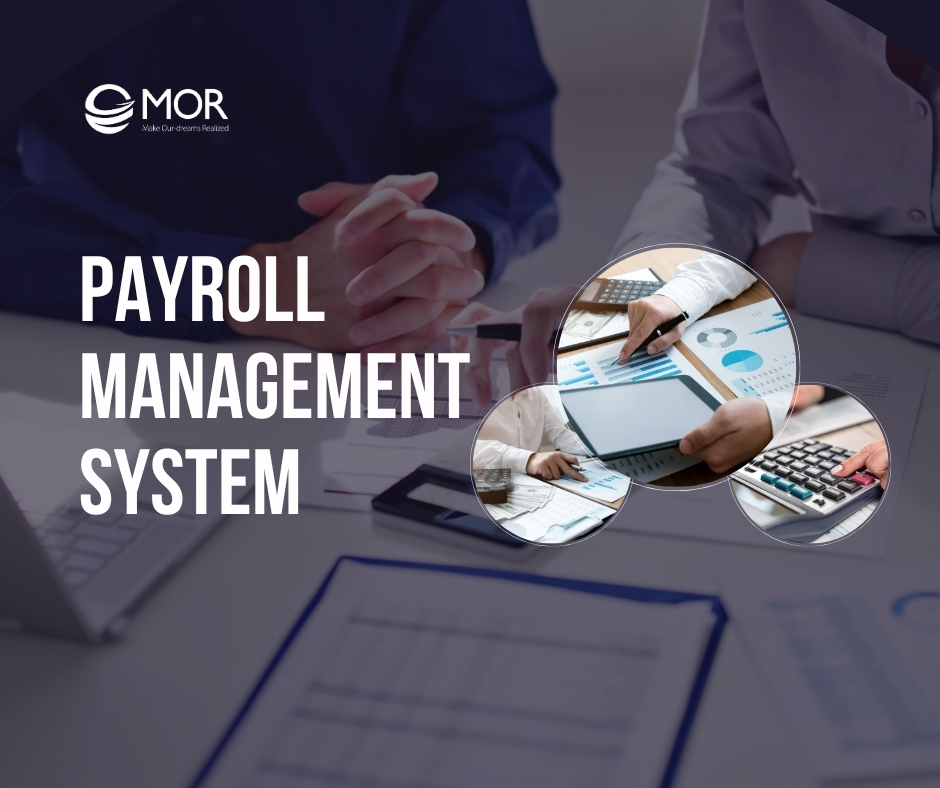
Tired of spreadsheets and late salary runs? A payroll management system gives you a smarter, faster way to manage pay, taxes, and compliance. This MOR Software’s guide will break down everything you need to know, from core features to top providers in 2025, to help you choose the right solution for your business.
What Is Payroll Management System?
A payroll management system is a digital tool that helps businesses handle employee compensation from start to finish. It calculates wages, processes tax deductions, logs work hours, and issues payments. Some systems also support tax filing and generate digital payslips.
Modern platforms can sync with tools like HR systems and CRM platforms, giving payroll teams a full picture of workforce data.
Because demand keeps rising, analysts expect the global cloud-based payroll software market to climb from about USD 26.1 billion in 2025 to USD 54.2 billion by 2034. This is a compound annual growth rate of roughly 8.5%.
Whether you’re running a lean startup or a growing mid-size business, the right payroll management program depends on your team size, payment structure, and growth goals. Many businesses use these systems to simplify the way they define payroll management in their operations.
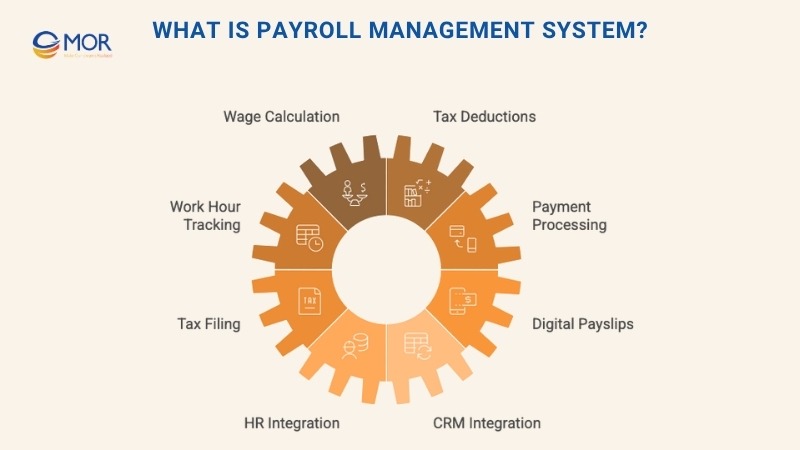 What Is Payroll Management System?
What Is Payroll Management System?
Core Features of a Payroll Management System
When choosing a payroll management system, pricing matters but it’s not the only thing. You’ll want to balance cost with features that match your workflow. The goal is to find software that covers what you need without paying for extras you won’t use.
Even with widespread cloud adoption in other functions, 67% of enterprise infrastructure is now cloud based, only 26% of companies say their payroll operation is fully cloud based. This leaves plenty of room for improvement.
Key features to look for in reliable payroll management software include:
- Salary calculations: Accurate gross and net pay, including deductions for taxes, benefits, garnishments, and retirement plans.
- Tax support: Tools that handle both withholding and submitting taxes to the right authorities, automatically and on time.
- Payment options: Support for multiple pay methods, like direct deposit, physical checks, digital wallets, or pay cards.
- Time tracking: Built-in time tracking or seamless integration with third-party tools for hourly staff or shift-based roles.
- Benefits management: Ability to manage health, dental, vision, retirement, or workers’ comp benefits directly from the platform.
- Self-service tools: A clean interface where employees can update personal details, view payslips, or change tax withholding.
- Reputation and reliability: Always check provider feedback, especially from companies in your industry, to ensure strong administration payroll features and long-term performance.
 Core Features of a Payroll Management System
Core Features of a Payroll Management System
Common Methods of Payroll Management System
Not all payroll management systems work the same way. Choosing the right structure depends on your team’s size, tools, and how involved your payroll manager needs to be in daily operations. Let’s break down the common formats you’ll find in today’s market.
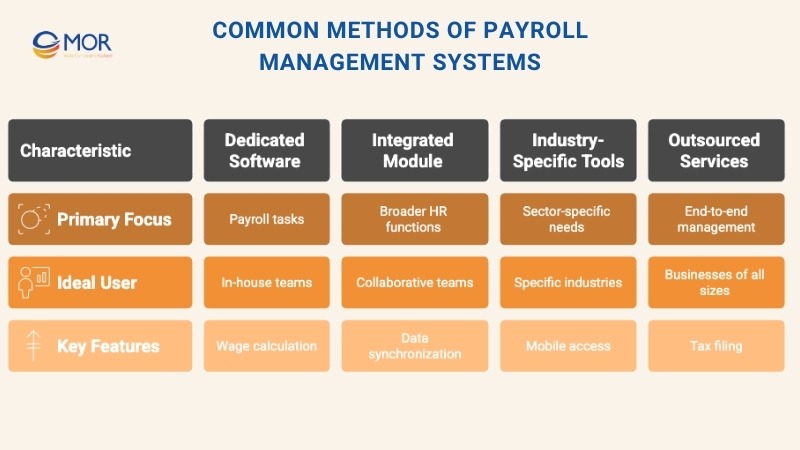 Common Methods of Payroll Management System
Common Methods of Payroll Management System
Dedicated Payroll Software
These tools focus strictly on payroll tasks. They’re ideal if you want to manage payroll in-house without relying on outside providers. They calculate earnings, deductions, and taxes but you’ll need to handle tax filing separately.
Most platforms in this category are cloud-based, so your finance team can log in from anywhere. Firms that automate payroll this way report cutting processing time by about 30% on average. And some all-in-one systems document savings as high as 90%, freeing HR to tackle more strategic work.
If your business has international workers, some systems offer multi-currency support and cross-border tax rules to match.
Integrated Payroll Module
This option is part of a larger HR platform. Instead of separating payroll from hiring, benefits, or performance reviews, everything is in one system. It gives your team full visibility across the employee lifecycle.
For companies hiring for payroll manager positions, this all-in-one format makes it easier to streamline reporting and collaborate with HR or operations teams.
Niche Payroll Tools by Industry
Some sectors, like food service, construction, or healthcare, have payroll quirks that general tools can’t handle. That’s where industry-specific software comes in.
These systems are tailored to handle things like shift pay, tips, union dues, or job-site rotation. They also support mobile access and shift scheduling, which is critical for hourly workforces.
Outsourced Payroll Services
Want to hand off the entire process? Some companies go with a full payroll management service instead.
- Full-service payroll providers handle everything: pay runs, tax filing, reporting, and compliance.
- Professional Employer Organizations (PEOs) go further by managing HR risks, benefits, and even worker classification under their legal entity.
Benefits of Using a Payroll Management System
Switching to a payroll management system gives your team more than just automation, it gives control, accuracy, and peace of mind. Whether you’re a small business owner or a dedicated payroll manager, these systems help streamline work, support compliance, and protect sensitive information across every pay cycle.
- Saves time by automating repetitive tasks: Manual data entry takes hours. With a digital payroll management platform, everything from salary calculations to payslip generation runs on schedule.
- Reduces calculation and filing errors: Built-in rules for tax deductions and benefits help you avoid costly mistakes and meet deadlines with confidence. PwC analysis shows payroll mistakes cost the average FTSE 100 company between £10 million and £30 million every year, a reminder that accuracy directly protects the bottom line.
- Keeps payroll data safe and accessible: Cloud-based systems offer secure storage, backups, and easy access for authorized staff.
- Increases transparency with employee access: Workers can check their earnings, update details, and download documents without contacting HR.
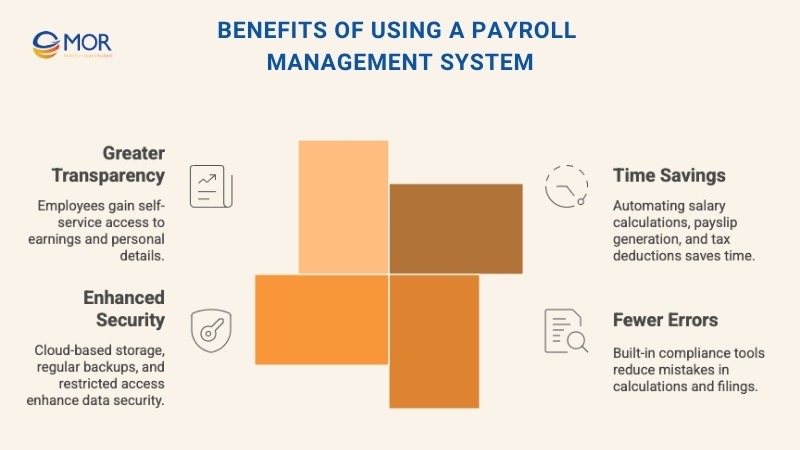 Benefits of Using a Payroll Management System
Benefits of Using a Payroll Management System
Best Payroll Management System Providers for Businesses in 2025
We’ve reviewed top payroll management system providers built for speed, accuracy, and flexibility. Whether you're scaling fast or handling complex requirements, these platforms are worth a look.
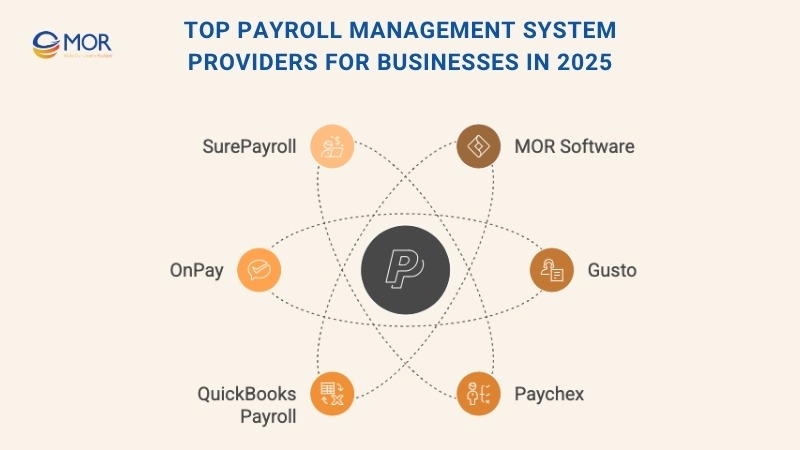 Best Payroll Management System Providers for Businesses in 2025
Best Payroll Management System Providers for Businesses in 2025
1. MOR Software Review – Best Overall Small Business Payroll Provider
MOR Software is a leading custom payroll and HR software development company, known for delivering tailored solutions to small and midsize businesses worldwide.
With deep expertise in fintech and enterprise automation, MOR builds flexible payroll management systems that cover everything from automated pay runs to tax filing, compliance support, and real-time employee self-service.
The company specializes in scalable solutions that grow with your team and can integrate directly into your existing HR or accounting systems.
Key features
- Full-service, automated payroll processing
- Custom Payroll AutoPilot for recurring payrolls
- AI-powered error detection and audit trails
- Modular platform with access to benefits, insurance, and leave tracking
- Automated tax calculations, filings, and payments
- Compliance monitoring for federal, state, and multi-jurisdictional regulations
- Integrated time tracking tools with web, mobile, and kiosk access
- Payroll and tax support tailored to local laws
- One-on-one implementation support and ongoing system training
- White-label mobile app or web portal for both employers and employees
The main takeaway?
MOR Software’s small business payroll platform is ideal for teams that want full control, automation, and customization. It supports growing businesses with flexible architecture, AI-driven error detection, and integrated HR tools, all backed by a dedicated software engineering team that builds systems around the way you work.
2. Gusto Review
Gusto is a cloud-based payroll and HR platform tailored to small businesses. It provides payroll processing, automated tax filings, and benefit management in a user-friendly interface.
Gusto also includes tools for hiring, onboarding, and employee self-service. It supports contractor payments and offers over 100 integrations with accounting and productivity apps. Support is available through phone, chat, and email.
Key features
- Full-service payroll processing
- Unlimited payroll runs
- Automated tax calculations and filings
- Employee self-service
- Benefits administration
- Hiring and onboarding tools
- Time tracking features
- Accounting software integrations
- Gusto Wallet app for spending and saving
- Mobile payroll tools
The main takeaway?
Gusto is a solid choice for small businesses needing a flexible, all-in-one payroll management system. With intuitive tools for employee onboarding, benefits, and compliance, it helps simplify payroll operations while integrating well with existing tools.
3. Paychex Review
Paychex Flex delivers payroll and HR solutions suited for both small and growing businesses. The platform automates payroll tasks and offers built-in tools for tax administration, employee benefits, and workers' compensation.
Employers also gain access to HR features like time tracking, performance reviews, and analytics. Paychex offers both self-service tools and personalized HR guidance.
Key features
- Automated payroll processing
- Tax filing and compliance support
- Employee benefits management
- HR support and tools
- Time and attendance tracking
- Workers’ compensation integration
- Advanced reporting and analytics
- Employee self-service portal
- Mobile app for both employers and employees
The main takeaway?
Paychex is a trusted solution for businesses that want both automation and live support. It’s built to scale with growing teams and brings together payroll, HR, and compliance in one dashboard.
4. QuickBooks Payroll Review
QuickBooks Payroll is an extension of Intuit’s accounting platform, offering small businesses integrated payroll features. It handles direct deposits, automated tax payments, and employee access to pay stubs.
QuickBooks supports same-day payroll, customizable reporting, and add-ons for benefits. It works seamlessly for existing QuickBooks accounting users but does not integrate with non-Intuit platforms.
Key features
- Automated payroll runs
- Same-day direct deposit
- Federal and state tax automation
- Unlimited payroll processing
- Employee portal for self-service
- Time tracking integration
- Benefits management tools
- Payroll reporting customization
- Compliance monitoring
- Mobile app for payroll access
The main takeaway?
QuickBooks Payroll is ideal for businesses already using QuickBooks for accounting. Its tight integration and strong automation make it easy to run payroll and stay compliant, although it’s best suited for businesses that don’t need third-party accounting integrations.
5. OnPay Review
OnPay is a cloud-based payroll management system built with small businesses in mind. It supports unlimited payroll runs, handles multi-state filings, and includes features for onboarding and self-service.
OnPay also offers benefits management, time tracking integrations, and flexible pay schedules. Support is available through phone and chat on weekdays, with email support for weekends.
Key features
- Unlimited monthly payroll processing
- Multi-state payroll and filings
- Automatic tax calculations and submissions
- Employee onboarding workflows
- Employee self-service access
- Integrations with accounting and time tracking tools
- Flexible payment schedules and pay types
The main takeaway?
OnPay is straightforward, reliable, and cost-effective. Its clean interface and wide range of core features make it a practical choice for small teams looking to automate payroll without unnecessary complexity.
6. SurePayroll Review
SurePayroll, a Paychex company, offers payroll management system tailored to small businesses and freelancers. It automates payroll tax filings, includes employee portals, and integrates with benefits providers. The platform provides flexible pay options and customizable reporting. Live support is offered by phone, email, and chat during business hours, with limited weekend coverage.
Key features
- Cloud-based payroll processing
- Payroll tax calculations and filings
- Self-service portals for employees
- HR and compliance tools
- Benefits integration
- Customizable payroll reporting
- Multi-state payroll support
- Live customer support via phone, chat, and email
The main takeaway?
SurePayroll brings simplicity to payroll and compliance for small businesses. With features that support various worker types and automated tax handling, it’s especially helpful for teams that want a straightforward, web-based payroll solution.
How to Choose the Right Payroll Management System for Your Business
Choosing a payroll management system isn't just about ticking boxes. It’s about finding the right fit for how you actually run your business. Use this checklist for payroll management best practices to make a confident, informed choice:
- Define your business needs. Do you only need basic payroll management tools, or do you deal with shift work, union dues, or multi-country compliance? Decide if you want tax filing, benefits management, or talent tracking in the mix.
- Set your budget. If you're running lean, look for payroll management software that offers basic plans or pay-as-you-go pricing. Got more room? Make sure the price actually delivers real value.
- Narrow your shortlist. Use trusted review sites, peer recommendations, and expert-curated lists. Avoid vendors with vague pricing, poor support, or outdated UIs.
- Test with a trial or demo. Run sample pay runs, have different teams try it, and gauge how intuitive the system is. Pay attention to how well it adapts to your current workflow.
- Choose a plan that can scale. Some payroll management programs offer flat pricing. Others have tiers. Either way, check integration options and add-ons that might matter as you grow.
- Implement and train. Most systems are easy to launch, but good training prevents errors down the line. Make sure your payroll manager, HR, and finance teams get hands-on time with the system.
Remember, nearly one in five employers still need more than two pay cycles to fix mistakes. And only 78% of pay runs are fully accurate worldwide, according to ADP’s 2024 global payroll survey.
Meanwhile, 20% of employers openly suspect they may be paying staff incorrectly. This just show show vital a reliable solution and a thorough demo really is.
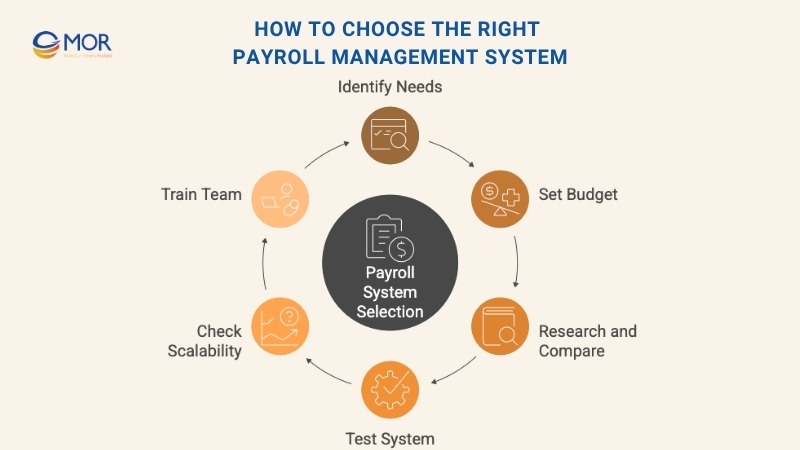 How to Choose the Right Payroll Management System for Your Business
How to Choose the Right Payroll Management System for Your Business
Conclusion
A reliable payroll management system isn’t just a back-office tool, it’s a safeguard for your operations and a key to building trust with your team. From cutting down manual tasks to staying compliant across regions, the right system brings both control and clarity to your pay process. As your business grows, so do your payroll needs. That’s where a flexible, secure, and scalable solution matters.
If you're planning to build a custom system or upgrade what you’ve got, MOR Software brings the deep technical skill and real-world payroll experience to make it happen. Contact us to talk about what fits your team best.
Rate this article
0
over 5.0 based on 0 reviews
Your rating on this news:
Name
*Email
*Write your comment
*Send your comment
1